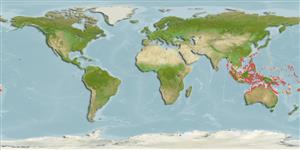>
Syngnathiformes (Pipefishes and seahorses) >
Syngnathidae (Pipefishes and seahorses) > Syngnathinae
Etymology: Halicampus: Greek, als, alis = salt + Greek, kampe = bend (Ref. 45335).
More on author: Günther.
Environment: milieu / climate zone / depth range / distribution range
Ecología
marino asociado a arrecife; rango de profundidad 1 - 20 m (Ref. 90102). Tropical; 30°N - 23°S
Western Pacific: Viet Nam to Fiji, north to Ryukyu Islands, south to Rowley Shoals and New Caledonia; Belau in Micronesia.
Tamaño / Peso / Age
Maturity: Lm ? range ? - ? cm
Max length : 7.3 cm SL macho / no sexado; (Ref. 1602)
Espinas dorsales (total): 0; Radios blandos dorsales (total): 18-22; Espinas anales 0; Radios blandos anales: 3. Superior trunk and tail ridges discontinuous; inferior trunk ridge ending at anal ring; lateral trunk ridge continuous with inferior tail ridge; body rings 13-15 + 30-32.
Adults inhabit reef flats to a depth of over 17 m. Easily recognized by color but secretive and not often seen (Ref. 48635). Ovoviviparous (Ref. 205). The male carries the eggs in a brood pouch which is found under the tail (Ref. 205). Also seen in coral reefs in 1-20 m (Ref 90102).
Life cycle and mating behavior
Madurez | Reproducción | Puesta | Huevos | Fecundidad | Larva
Male carries the eggs in a brood pouch (Ref. 205).
Myers, R.F., 1991. Micronesian reef fishes. Second Ed. Coral Graphics, Barrigada, Guam. 298 p. (Ref. 1602)
IUCN Red List Status (Ref. 130435)
Threat to humans
Harmless
Human uses
Más información
ReferenciasAcuiculturaPerfil de acuiculturaRazasGenéticaElectrophoresesheritabilidadEnfermedadesProcesamientoNutrientsMass conversion
ColaboradoresImágenesStamps, Coins Misc.SonidosCiguateraVelocidadTipo de nataciónSuperficie branquialOtolitosCerebrosVisión
Herramientas
Special reports
Download XML
Fuentes de Internet
Estimates based on models
Preferred temperature (Ref.
123201): 25.6 - 29.3, mean 28.6 °C (based on 1778 cells).
Phylogenetic diversity index (Ref.
82804): PD
50 = 0.5002 [Uniqueness, from 0.5 = low to 2.0 = high].
Bayesian length-weight: a=0.00037 (0.00016 - 0.00085), b=3.18 (2.99 - 3.37), in cm total length, based on LWR estimates for this (Sub)family-body shape (Ref.
93245).
Nivel trófico (Ref.
69278): 3.2 ±0.4 se; based on size and trophs of closest relatives
Resiliencia (Ref.
120179): Alto, población duplicada en un tiempo mínimo inferior a 15 meses (Preliminary K or Fecundity.).
Fishing Vulnerability (Ref.
59153): Low vulnerability (10 of 100).
Nutrients (Ref.
124155): Calcium = 217 [117, 481] mg/100g; Iron = 1.28 [0.64, 2.30] mg/100g; Protein = 17.8 [16.5, 19.0] %; Omega3 = 0.12 [0.06, 0.25] g/100g; Selenium = 35.6 [15.0, 91.4] μg/100g; VitaminA = 78.4 [22.3, 266.1] μg/100g; Zinc = 2.66 [1.64, 4.04] mg/100g (wet weight);
